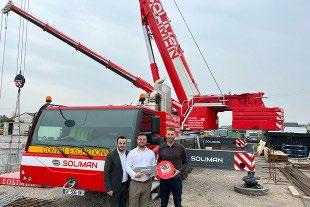
14 minute read
cranes and grabs
from BTI Summer 2022
by Maritime-AMC
SEIZING THE ADVANTAGE
Investment in crane and grab systems has continued this year with an emphasis on putting in place equipment that will be eco-friendly as well as efficient
Associated British Ports (ABP) will further reduce its carbon emissions, as two of the very first fully mains-electric powered hydraulic cranes arrive at the Port of Ipswich. These cranes are among the first of their kind in the UK and are the latest in a series of bold investments in sustainable measures from ABP that have contributed to a 36% decrease in greenhouse gas emissions since 2014.
The cranes, Mantsinen model 95ER, have been configured around specific workings of the operations at the Port of Ipswich to optimise efficiencies and further reduce energy consumption. It is estimated that these two electric cranes will save up to 5,275 tonnes of CO2 over their lifetime. To provide perspective, one tonne of CO2 is equivalent to driving a car once around the world (circa 23,000 miles).
ABP has partnered with provider Cooper Specialised Handling in this pioneering agreement to invest in these multi-million-pound, state-ofthe-art cranes that can be powered by the solar energy generated at the port itself. The port already has 4,000 solar rooftop solar arrays and has invested in an onsite sub-station to futureproof sustainable portside operations that can accommodate up to four electric powered cranes. The port has also invested in electric vans to minimise the impact of port operations on the environment.
The two cranes will be able to manage a range of material received in the East Anglian port, which handles more than two million tonnes of cargo each year and is the UK’s leading grain export port.
Not only will this initiative improve ABP’s green credentials, reducing the port’s CO2 emissions and decreasing energy consumption by up to 40%, but will also allow for quieter operations and improved air quality.
Paul Ager, divisional port manager says: “ABP is really committed to reducing the greenhouse gas emissions arising from port activity. This £4m investment at the port is the latest development in ABP’s carbon reduction goals tailored to its operations.
“The transition to electric machines will not only improve ABP’s cargo handling service to its customers but will also feed into ABP’s wider policy to reduce CO2 emissions all the way down to zero.”
liebherr’s higher level
French crane contractor Soliman has taken delivery of a new Liebherr LTM 1230-5.1 mobile crane. The higher lifting capacities of the powerful, versatile fiveaxle crane compared with other models in the same crane class, together with its particularly long boom, were just some of the criteria that made up the company’s mind to buy the new crane.
HANDOVER OF THE LTM 1230- 5.1 TO SOLIMAN LEFT TO RIGHT: ENZO GIGANTE, GIUSEPPE GIGANTE (BOTH FROM SOLIMAN) AND GUILLAUME GAENG (LIEBHERR GRUES MOBILES).
One of the factors that persuaded the company to buy the Liebherr 5-axle model was its high resale value on the secondhand market. Soliman is also impressed with the reliability of Liebherr cranes: “We chose Liebherr when we decided to develop our fleet as a result of the reliability of Liebherr cranes and
the fact that they often deliver higher lifting capacities compared with others in the same crane class,” explains Enzo Gigante, commercial manager at Soliman. “We decided on the LTM 1230-5.1 from Liebherr because of its great boom length, versatility and high performance.”
The 230 tonne model features a very long 75m telescopic boom. This can also be combined with a 43m fixed jib. That makes high radii possible, for example for hoisting loads over buildings. Its maximum hoist height is 111m. In addition, there is a wide range of auxiliary boom systems available for this crane model, which can be adjusted hydraulically as an option.
The crane‘s VarioBase® and VarioBallast® features ensure that it is also ideal for working in constricted conditions. The LTM 1230-5.1 was the very first crane to feature an asymmetrical support system, known as VarioBase® Plus. This combines trapezoidal support with VarioBase® technology. It means that even higher lifting capacities are possible, particularly over the crane’s rear outriggers.
The new LTM 1230-5.1 joins the higher lifting capacity segment within the Soliman crane fleet. “The crane fits perfectly in the heavy load cranes within our fleet”, adds Gigante.
“We work in every sector where a crane is required, such as construction and general industry.”
Meanwhile, Liebherr is unveiling fibre cranes for particularly challenging hook heights and hoists. When it launched its pioneering fibre rope over three years ago, Liebherr also unveiled its first fibre cranes in its popular EC-B series. Flat-top cranes featuring a high-tensile fibre rope, which is the result of 10 years of development work by Liebherr and rope manufacturer Teufelberger, are now showing what they can do every day on sites around the world.
For the very first time, HC-L and EC-H series cranes will now be available in fibre versions – the crane for special projects, the 1188 EC-H 40 Fibre, and the luffing jib crane, the 258 HC L 10/18 Fibre. The high-tensile fibre rope for large cranes has a diameter of 25mm (previous versions measured 20mm and 22mm in diameter). The significant weight difference between a 25mm steel rope and a fibre rope of the same thickness means that the new fibre cranes can be used to build skyscrapers and industrial plants with even greater efficiency.
The latest “Tough Guys” from the EC-B series, the 370 EC-B 16 Fibre and the 520 EC-B 20 Fibre, also feature the 25mm fibre rope.

THE 258 HC-L 10/18 FIBRE CRANE NOW ALSO FEATURES THE 25MM FIBRE ROPE FROM LIEBHERR.
The lighter fibre rope is particularly noticeable on specialist cranes for great hook heights, the HC-L cranes. This is because every metre of additional hook height means that the benefits of this significantly lower rope weight increase. The use of the fibre rope enables the lifting capacities at the jib head to be increased by up to 20% compared with the steel rope versions.
In addition, the fibre rope delivers a significantly longer service life than a steel rope. As the fibre rope only weighs around one-fifth of a steel rope, it is also significantly easier to handle for erection engineers when reeving the hoist rope. Furthermore, the fibre rope is easier to maintain as it does not require lubrication. That also means that the downtimes of the crane are reduced.
What is more, safety during crane operations is palpably increased – the various components of the cover wear at different rates, and the crane operator can see at a glance that the rope has to be replaced at the latest when the red layer under the cover fabric appears.
In addition, fibre ropes deliver another method of reducing an ecological footprint. This is due both to the rope material and the fact that it makes it possible to use a lighter crane construction.

HOISTING WORK CAN BE COMPLETED QUICKLY AND SAFELY USING THE NEW 258 HC-L 10/18 FIBRE (FRONT LEFT) FROM LIEBHERR.
Liebherr has also unveiled its first hydraulic luffing jib crane. The 195 HC-LH 6/12 can hoist up to 2550 kilograms at the jib head at its maximum radius. The hydraulic luffing jib crane achieves these fantastic values when combined with the climbable 16 EC tower system, whose dimensions of 1.6 x 1.6m mean it has a very small footprint and can be transported easily to the site by truck or container.
Slimline tower systems, great hook heights, high performance and climbable – Liebherr claims this complete package makes its hydraulic luffing jib crane unique.
In addition, the hydraulic luffing jib crane also particularly stands out from the crowd due to the fact that it is easy to erect and very simple to transport.
It also has state-of-the-art features that include a very small out-ofoperation setting and the facility to control it using the popular Litronic assistance systems such as Micromove, the operating-range limiting system and level luffing.
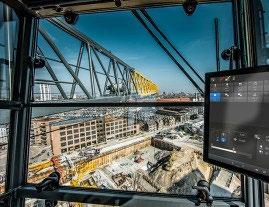
THE TC-OS SMART CONTROL INTERFACE IS ALREADY AVAILABLE. LIEBHERR IS DEVELOPING MORE
The construction site of the future not only requires powerful machines but also smart digital solutions for crane operations. Liebherr will provide an insight into new planning and analysis tools, such as 3D models for planning a site in detail. A digital site diary helps to analyse the efficiency of the construction machinery in retrospect.
Furthermore, Liebherr is working on solutions to improve crane operating even more – first of all in the form of the new intuitive TC-OS control interface and, second, by remote control for tower cranes. The new control interface, which is already in use in many cranes, enables crane operators and service engineers to navigate through a practical menu structure using a touchscreen. The remote control enables the crane operator to control the crane from outside the cab. This means greater flexibility in structuring the working day.
Another focus is the development of new assistance systems that support crane operators using intelligent sensors and algorithms and therefore make a major contribution to enhancing safety on site.
Port Qasim purchase
Port Muhammad Bin Qasim has purchased two grab unloaders to help with its handling of dry bulk cargo.
The DM25T-43M grabs are designed and manufactured by Nanjing Port-Machinery & Heavy-Industry Manufacture Company (NPHMC), China.
The system includes a hopper, fully closed belt and dust control system, which is energy-efficient and environmentally friendly.
Its design facilitates fast loading times and it is also cost competitive when compared with European manufactured machines, the company says.
Rough terrain
Tadano has announced its plans to commercialise the world’s first electric rough terrain crane.
Currently in development, the crane will be able to drive to the job site and complete all lifting operations using battery/electric, rather than diesel power, to deliver zeroemissions operation.
Beyond its environmentally friendly operation, the crane’s electric motor emits lower noise levels when operating. This will result in significant advantages for customers when working in congested urban areas with noise ordinances, completing lift projects at night and operating indoors.
Tadano is currently working with a variety of industry suppliers and partners and targets commercialisation of the new electric rough terrain crane in late 2023.
In April 2021, Tadano Group announced long-term environmental targets, which include a 25% reduction in CO2 emissions from business activities and a 35% reduction in CO2 emissions from product use by 2030, as well as achieving net-zero carbon emissions by 2050.
The company has gathered all of its sustainable solutions under the name Tadano Green Solutions (TGS). Combined with lifting technology, the innovations introduced under TGS will contribute not only to sustainability, but also to operating safety, quality and efficiency.
Introducing the world’s first electric powered rough terrain crane is the next evolutionary step in meeting the company’s environmental targets.
Most of the crane equipment on the market today consumes diesel fuel to operate, Tadana says. For many models, the engine and drivetrain are required to both propel the crane to the jobsite and power the hydraulics used to lift loads. Diesel fuel is burned in the process, generating CO2 emissions. Under the TGS banner, electrification of the rough terrain crane product line is one of the key efforts for lowering product emissions.
“We have set aggressive goals for lowering both operational and product emissions and we will partner with industry leading companies to attain those goals,” says Toshiaki Ujiie, president, CEO and representative director of Tadano.
“In conjunction with previous product innovations to lower CO2 emissions, we are excited to introduce the first battery/electric rough terrain crane, which will be a key driver for our goal of 35% reduction in product CO2 emissions by 2030.”
FUCHS: VERSATILITY IS KEY
COMPANY NEWS
Hydraulic material handlers in ports have proved their efficiency and versatility over the past few decades. The reputation of these machines precede them; they have become the equipment of choice for both sea and river ports, as well as smaller bulk stand-alone terminals that deal in the loading and unloading of vessels.
Fuchs machines, in particular, have been used in port applications with great success. Fuchs material handlers work in ports worldwide, meeting and exceeding needs in the most demanding of applications and environments. At the request of our customers, Fuchs has developed new designs and machines that fit port applications to fully meet customer needs, to successfully work in and around ports.
One of the recent additions to the Fuchs range – which was driven by demand in the ports segment – is a crawler mobile hydraulic material handler with a gantry undercarriage, the RHL390F Gantry.
The gantry undercarriage allows the rail wagons or lorries carrying bulk to drive through the machine, which means that customers can optimise traffic on site, save space and handle the materials even more efficiently than with a standard gantry crane. Gantry material handlers such as this will also be more productive when working alone in loading/unloading from under the machine, in comparison to the more typical 180° rotation handling of other machines. Another advantage is view height – the gantry portal legs lift the cab to a higher position, allowing the operator a much clearer overview.
Optionally, the machine can be equipped with additional cameras providing a full 360° view for the operator, which drastically improves safety in and around the machine.
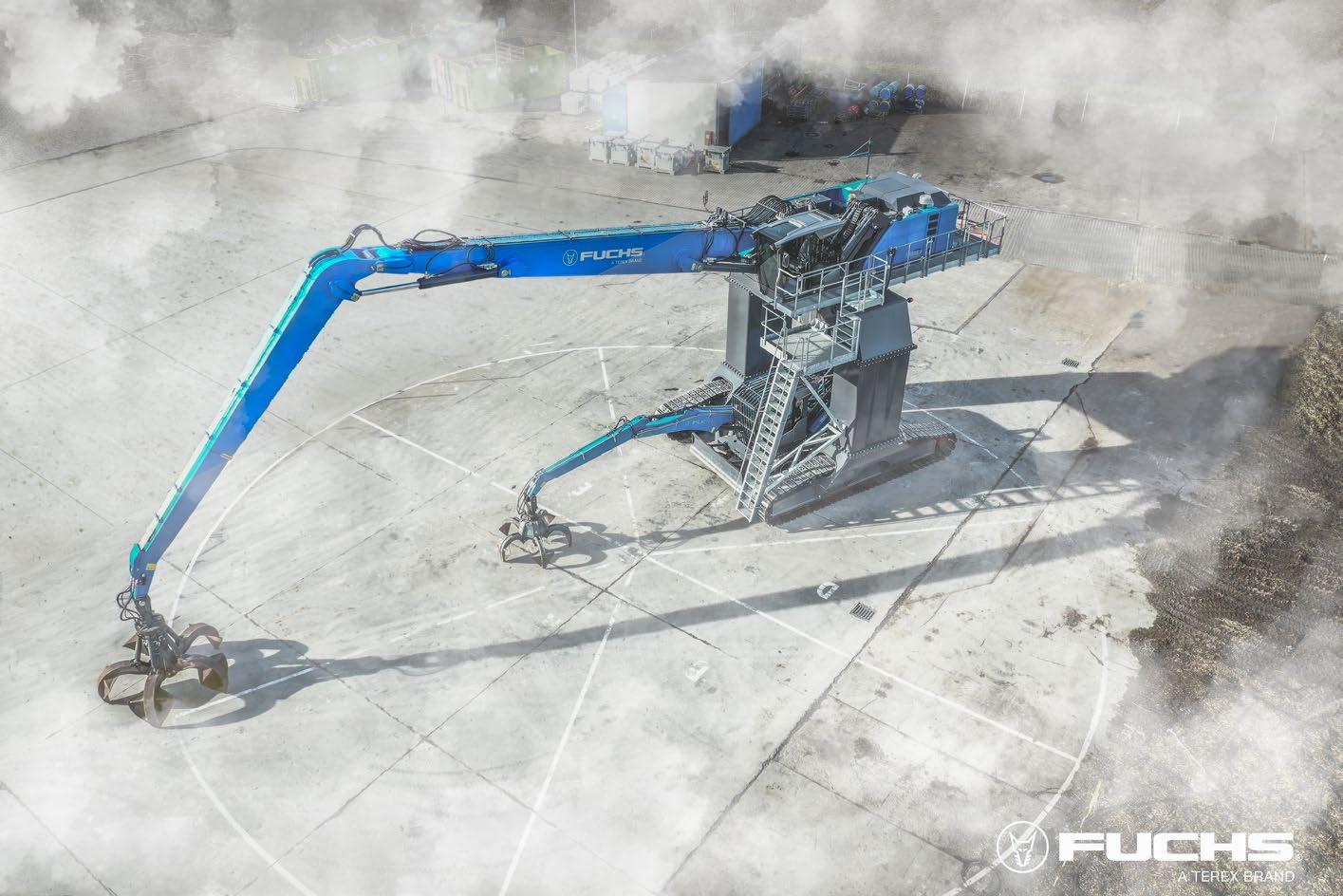
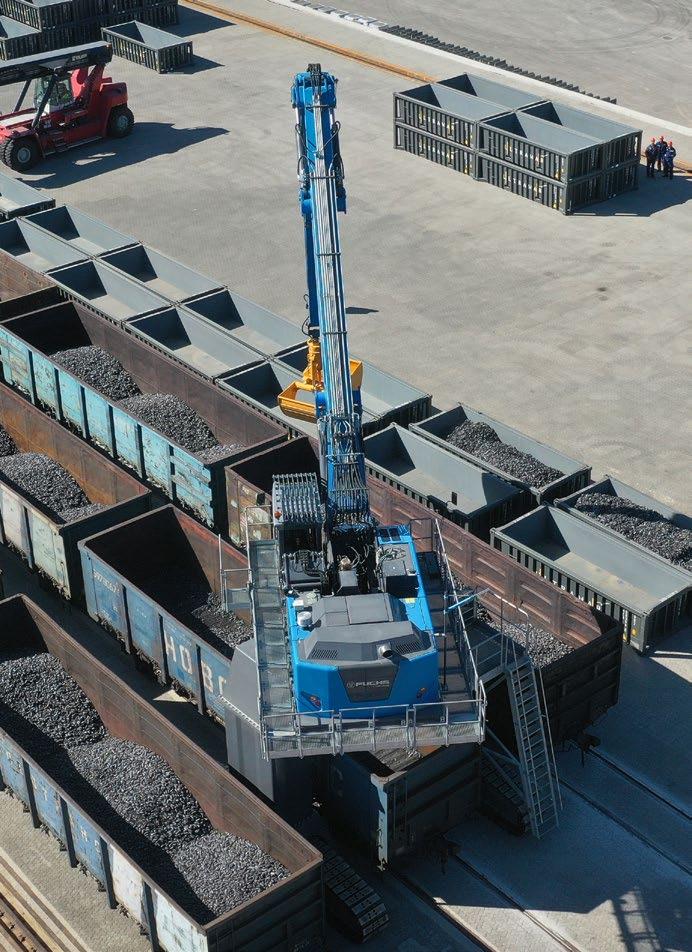
Another challenge often faced on port sites is range of reach, and due to the RHL390F Gantry having the gantry unit with a reach of over three tracks, this challenge is eliminated. The gantry portal legs lift the machine, upgrading the possibilities of the area of operation for the machine and it’s reach possibilities. An example of such an issue is operating over the middle rail track on a port site that is occupied by wagons. With the addition of the gantry portal leg,s it enables this machine to operate on the middle rail tracks – saving time in the loading/unloading process and also saving time having to move/remove rail wagons from one track to another.
At the same time, the reliable construction of Fuchs machines allows using a machine in HD mode over the multiple rail tracks. Currently one of the RHL390F Gantries is working in a dusty environment with 24/7 shifts and high density loads of up to 2,500-3,500kg/m³. The RHL390F Gantry machine can be also used in conventional loading/unloading/ sorting operations both on the quayside and in the rear areas of the port.
The Fuchs gantry unit has all the advantages that Fuchs has across the range:
» safe and easy access to major components via the Fuchs service platform » double-bearing system of the slewing ring for smooth loading cycles » separated high-performance coolers » dual pins on the boom and stick » metal hydraulic pipelines on the boom and stick » Full set of options for ports application » Possibility to build every machine with an electric drive » Five years telematics as a standard option. The name Fuchs has stood for innovative loading machine concepts for more than 130 years. Unique design features make our devices real all-rounders in material handling. Whether at the scrap yard, in recycling, in the sawmill industry or for use in ports, Fuchs machines stand for maximum productivity and economy everywhere.
For more information, contact: Terex Deutschland GmbH Geschäftsbereich Fuchs Industriestraße 3 76669 Bad Schönborn Germany Tel: +49 (0) 7253 84-0 Email: info.terex-fuchs@terex.com terex.com/fuchs
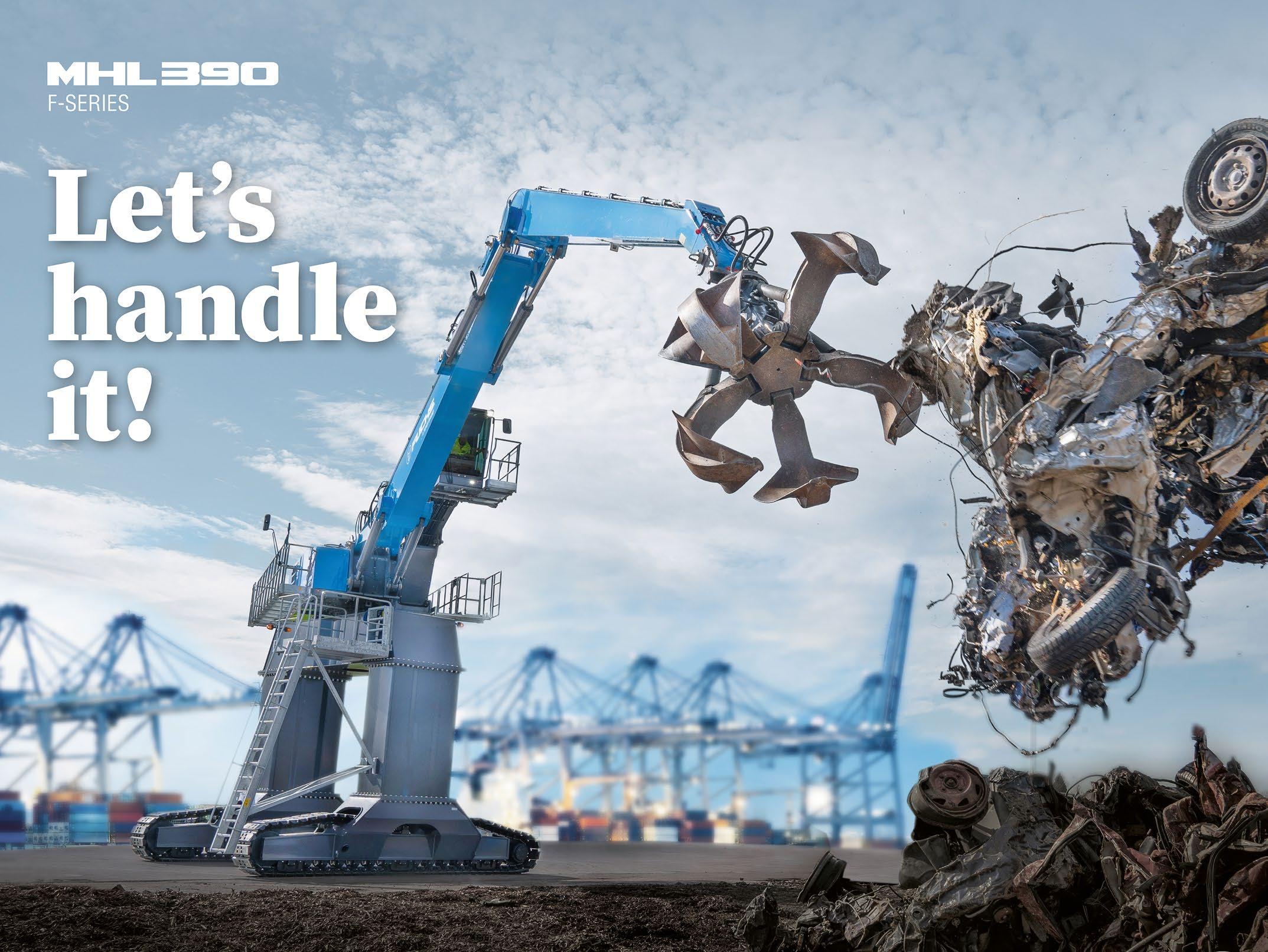
NEUERO: KICKSTARTING INNOVATION
COMPANY NEWS
French agri-food group Soufflet in Rouen recently took delivery of the new Neuero Kiko (kick-in kickout) shiploader, which has a loading capacity of up to 1,200t/h of grain with minimal dust emission. After four successful installations in the region, the Neuero Kiko DSH (dust suppression head) has impressed port operators with its efficient operation and high dust suppression, due to mass flow control.
The shiploader was assembled in Germany and transported using a heavy lift ship to France. The most significant advantage of this means of transport is the short downtime of the terminal. However, such transport is not easy and requires a lot of planning and preparation. Therefore Neuero and Soufflet already agreed on this shipment method at the beginning of the project so that lifting points and lashing points could be integrated into the machine design.
Heavy lift cranes set the shiploader into position at the site and Neuero was able to begin dry testing. The next step was hot commissioning after the site conveyor was ready.
So what is the difference that makes the Kiko DSH operate so efficiently and with the highest environmental standards available today? The answer is a combination of mass flow and pendulum movements. The mass flow allows loading of the cargo at low speeds, reducing dust emission. The shiploader does not eliminate dust completely, but reduces it significantly, therefore avoiding product segregation and slow material discharge speed. Older systems throw the product at boom height and try to stop it at arrival, especially during hatch trimming work where it is needed to fill all gaps.
The pendulum movement that we call Kiko allows the loading head to move simultaneously with the vertical telescope and enclosed system. Additionally, the slewing movement allows all areas of the hold to be reached, including the corners.
For more information, visit: neuero.de/en
READY FOR HOT COMMISSIONING

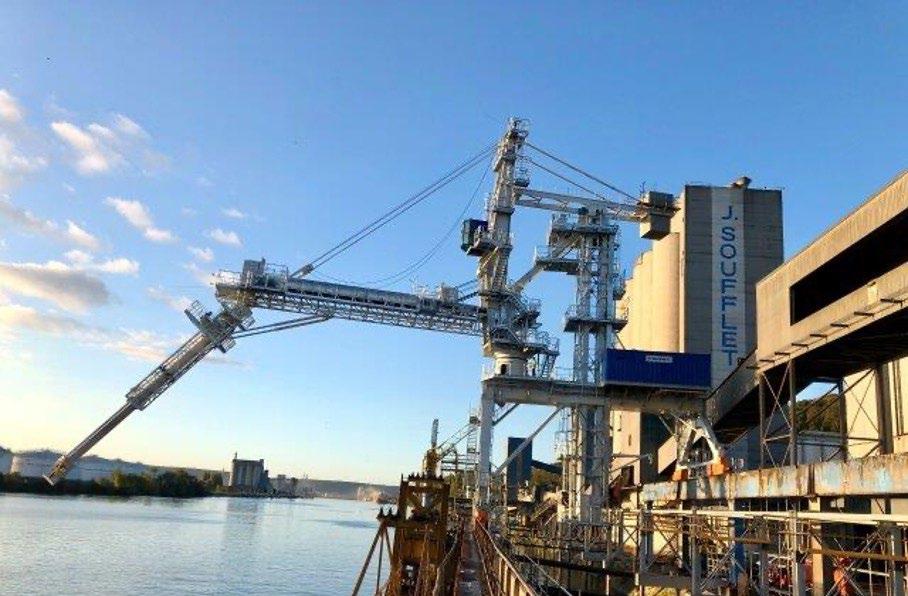
DEPARTING FROM GERMANY










